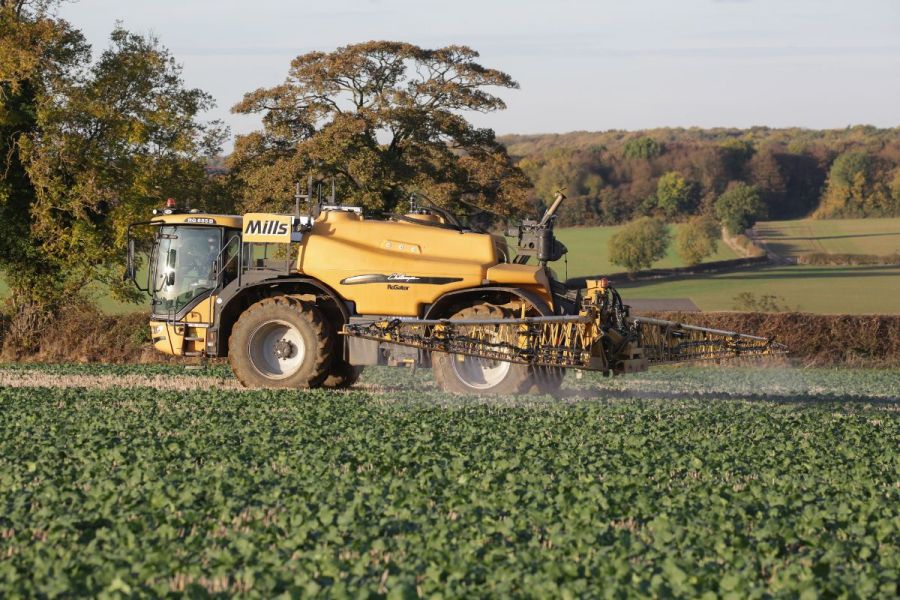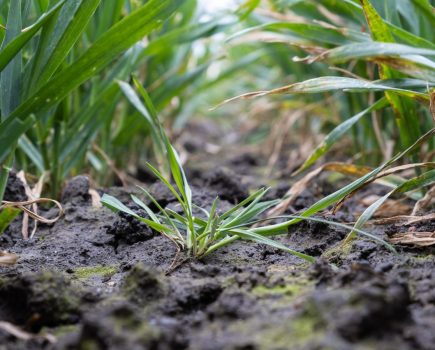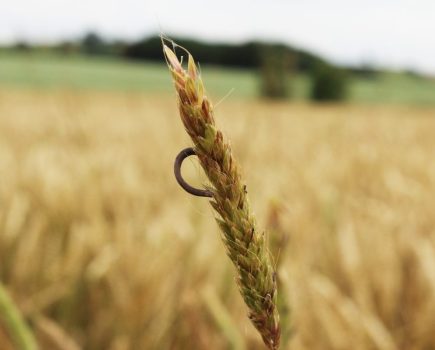With talk circulating of a severely low planted area of oilseed rape going into autumn, industry experts are highlighting why it’s a vital break crop – namely, the opportunity it provides for grassweed control. As such, CPM looks closer at one graminicide’s journey.
“Drilling early can remove one of the key tools for grassweed control in OSR.”
By Melanie Jenkins
Anyone regularly applying plant protection products will be familiar with conversations regarding resistance build up. However, by-and-large, despite clethodim’s long stint on the market, it’s still proving itself as a key product in the control of blackgrass.
It was more than 10 years ago when Centurion Max (clethodim) first received UK authorisation for application on a number of crops such as oilseed rape for grassweed control, and although other actives have succumbed to resistance, had their authorisation revoked or haven’t been renewed, clethodim continues to perform.
An ACCase inhibitor in group 1A, clethodim has the same mode of action as other FOPs, DIMs and DEN actives, says UPL’s Stuart Jackson. “They work on grassweeds by blocking the enzymes which catalise fatty acid synthesis, which are required for processes and metabolisation within the plant, stopping further growth. However, clethodim’s slightly different in terms of its resistance profile, which is why it’s still working so effectively and is integral to grassweed management programmes.”
With ACCase chemistry, the most common resistance mechanism is target site whereby a mutation at the site means herbicide can no longer bind with enzymes in the plant and so efficacy is reduced or voided, explains UPL’s Dr Alexander Zeller. “But to further complicate matters, there are a range of target site mutations which can result in varying activity between the FOPs, DIMs and DEN herbicides.”
Clethodim is unusual in that it’s less affected by target site resistance than other ACCase actives, in particular the I-1781-L mutation. This incurs resistance to cycloxydim (Laser) but not clethodim, despite both being DIMs, adds Stuart.
According to ProCam’s Rob Adamson, clethodim is therefore still useful for the control of both blackgrass and ryegrass. “ACCase chemistry is generally of little benefit in break crops when targeting blackgrass and ryegrass, however, clethodim is an exception to the rule and is a valuable tool. Although we’re likely to see a greatly reduced OSR area planted for 2024/25, it’s important to remember that this break crop gives the opportunity to deploy this option.”
Once Centurion Max has been applied, it targets the growing sites within the weeds and symptoms will start to appear after a week to 10 days, says Stuart. “What you’ll start to see is yellow-green tinge to grassweeds and a brown discoloration at the base. The youngest leaves will pull away easily and the inner stem will go brown and mushy. In warmer conditions, symptoms will appear quicker.”
From survey work conducted by Dr Stephen Moss between 2011 and 2014 — which Stuart believes is still relevant today —a range of blackgrass populations across England were assayed. “This determined the make-up of gene mutations that were in those samples, purely looking at ACCase mutations that would confer resistance to the FOP and DIM chemistry.”
The survey involved taking samples from 132 fields in England where 2574 plants assayed. “The results showed that in blackgrass, the dominant mutation is I-1781-L, being present in around 85% of the samples. The percentage points might have moved slightly since the survey was conducted, but they won’t have markedly changed,” says Stuart.
Present at low levels of around 8% in this study was a second mutation, A-2078-G. This is a mutation which is resistant to 120g/l of clethodim as well as the other FOPs DIMs and DEN herbicides.
From earlier ryegrass survey work conducted by Dr Stephen Moss in 2006/7 — 384 resistant plants were assayed from a sample of 54 populations across England.
“The overwhelming mutation with resistance to clethodim was A-2078-G, and essentially more than 50% of the sampled population has this gene, so it’s likely that in half of the ryegrass situations, clethodim could deliver disappointing results, if used as a stand-alone treatment.” he notes. “The second most common gene in the sample was still I-1781-L, which means clethodim has a role to play, but it does have to be supported.”
A more recent study conducted by Stephen in 2022/23 looked at two different elements. First, taking blackgrass and Italian ryegrass samples from fields and assessing petri dish assays after treating these with Centurion Max, and then taking any surviving material and retreating it to confirm resistance. The study looked at two different DIM products, clethodim and cycloxydim, at high and low doses, explains Stuart.
In the ryegrass samples, the I-1781-L mutation reacted better to higher levels of clethodim (0.4ppm and 1ppm, representation of field rate recommendations), showing the importance of using the correct dose, says Stuart. “But where the A-2078-G mutation was present this didn’t provide complete control during the assay tests. When retreating the survivors, all of the plants with A-2078-G survived but the I-1781-L mutations all died, demonstrating why we still see the performance in the field against 1781 but not A-2078-G,” he adds.
“The fact that low doses in the assay weren’t as effective on the I-1781-L population however, is a good reminder of the importance of dose, and adequate plant contact to ensure enough active ingredient is applied to the blackgrass.”
To get the best out of Centurion Max and to maximise herbicide uptake, the product should ideally be applied when the weed is at the correct growth stage, says Stuart. “Apply from three leaves to early tillering when the weed is actively growing.”
Air temperature should be 8-25°C as this provides optimum growing conditions, and clethodim shouldn’t be applied when there are frosts because the weeds won’t be actively growing, he explains. “It’s also recommended to always apply with a water conditioner such as X-Change, because this will provide improved performance of the herbicide.”
According to Rob, water conditioners and pH buffers help to improve the amount of the active ingredient that’s available to the weed and therefore more likely to kill it. “Where there’s 120g/l of clethodim in Centurion Max, you could lose a proportion of this to lock-up with minerals such as calcium without a water conditioner. Combine this with a tiny weed plant with little surface area to absorb the product, this can be where resistance starts.”
To achieve optimal coverage, Centurion Max should be applied with a minimum water volume of 200 l/ha of water. Stuart also warns growers to not trim the dose but to also not go above the 1 l/ha max dose rate.
Equally important to get the best out of the product is the growth stage of the crop. “Clethodim can be detrimental to OSR if an application is made too late when the flower buds are forming, therefore there’s a cut-off date of 15 October or at six leaves, whichever comes first,” explains Stuart.
“OSR forms its flower buds at about eight leaves which should be by late October or early November. But if clethodim is applied at this point, when the OSR is shutting down for winter and growth is slow, the plant can’t metabolise or break down the herbicide meaning clethodim becomes phytotoxic to the plant. This is expressed in the flower buds because they are the growing part of the plant, however, you won’t see symptoms until the flowering the following April,” he warns.
For those growers drilling early, this can severely limit or exclude the opportunities to apply the product, says Stuart. “For those planting in early August, OSR is likely to be past the six-leaf stage before the grassweeds are at the optimum size, or even emerged at all if the crop is rapidly growing. And although clethodim can be applied before October, there’s a risk of a second flush from grassweeds when applying it earlier. This means drilling early can remove one of the key tools for grassweed control in OSR.”
Rob concurs that drilling early limits the period growers have to apply Centurion Max. “Growers might find that by drilling early, they have a rapidly growing crop which reaches the six leaf cut-off before there’s sufficient emergence of the target grassweeds. Although it’ll control cereal volunteers which have emerged, there are other ACCase products which can be used to control these; clethodim has to be used to target blackgrass and ryegrass which generally won’t flush until October. You also have to factor in that clethodim is a nuanced active – it’s really good but works better on larger blackgrass plants than smaller ones.
“Waiting until the grass is starting to tiller is therefore beneficial, however with only a narrow window when OSR will be between growth stages 14-16 – as specified on the Centurion Max label – there’s a fine balance in getting adequate sized grass while avoiding exceeding the six leaf cut-off where the crop is then at risk of phytotoxicity.”
The earlier sown crops will have grassweed flushes within the crop because these won’t have been caught in a stale seedbed with glyphosate, warns Stuart. “And because the OSR will be too advanced to apply Centurion Max, growers are then relying on propyzamide – although it’s a residual, it only penetrates 5cm into the soil, while grassweeds can put down deep root systems by the time it’s applied.”
This is a situation that’s putting greater pressure on valuable chemistry, he warns. “In this scenario, the grassweeds are bigger and stronger and you’re then exposing them to propyzamide but not actually killing them with it.”
In the opposite situation, where OSR crops are drilled late and only emerge from the ground in mid to late September, from a clethodim stewardship point of view, plants might not reach the label stipulation of four-six leaf, before the 15 October stewardship cut-off.”
After several years without severe phytotoxicity issues in OSR, Rob warns there could be some complacency regarding the product’s stewardship. “It’s easy to forget why these guidelines were set, however, it’s dangerous to ignore them because the impact on overdosing or badly timed applications can be dramatic in OSR.”
Alexander advises growers to ensure overlap is eliminated, spots aren’t missed, application speeds and boom heights are optimised and adds that it’s suitable to be administered with low drift nozzles.
Furthermore, the product shouldn’t be applied when the target weeds are wet or there’s a high dew. “First let it dry before making an application,” says Stuart. “Ideally you want it to remain dry for the following 12-hours to allow time for it to be fully taken into the plant.”
In situations where growers have opted to omit a pre-emergence herbicide and wait until they feel there’s a viable crop before spending on pesticides, they could be faced with a dilemma between controlling broadleaf weeds or grassweeds, highlights Stuart.
“If broadleaf weeds are the main issue, growers might apply Belkar (halauxifen-methyl+ picloram) however, they should determine that there are no impacts to the OSR crop before going in with Centurion Max after leaving a 10-day window between applications.”
But if blackgrass is the main issue, Centurion Max is likely to be applied first and growers should then leave 14 days before applying another plant protection product to ensure there’s no impact to the crop, he adds. “It’s also important to make sure the following herbicide isn’t having an effect on the weed you’re aiming to control with Centurion Max.”
The next stage in the grassweed programme would be to target them again in November or December with a propyzamide product, says Stuart. “From a stewardship and resistance management point of view, it’s important to follow up Centurion Max with propyzamide, especially where there are 2078 mutations present.”
Centurion Max plus a water conditioner can be tank mixed with an insecticide or with propyzamide, but not with both, he highlights. “It’s a case of mixing it with one or the other depending on the situation and what’s most critical.”
For those wishing to combine the benefits of a contact and a residual herbicide, there are a few limiting factors. “Clethodim can be safely tank mixed with Kerb (propyzamide), but propyzamide can only be applied from 1 October and if you want to achieve the best results from both products, clethodim is best applied in early October and propyzamide in November,” adds Stuart.
Rob adds: “An application of the clethodim and propyzamide mixture can be helpful where grassweed emergence is incomplete or the grassweeds are small or shaded by the OSR plants, but the growth stage of the OSR means the application of clethodim can’t wait any longer.
“In these situations, propyzamide is a useful complementary mode of action to ensure the herbicide application is effective. The mixture will be an equally useful tool where the A-2078-G mutation is present,” continues Rob. “Mixing clethodim with propyzamide to aid the control or resistant populations is a useful way to restrict the spread of resistance. In ryegrass in particular, clethodim can’t reliably be used as a stand-alone treatment, but as last autumn has taught us, it’s not always possible to apply a follow-up application and if you don’t, you can soon select for a completely resistant population.”
Although Centurion Max is the main product containing clethodim growers are likely to be using, Rob highlights that there are others on the market, some of which are exclusively for use on sugar beet, while others have different concentrates of clethodim in them or have different application rates. “It can’t be assumed that 1 l/ha is always the full label dose, and with 180g/l products available, it would be an easy trip hazard to not read the label, and exceed the maximum dose- resulting in likely crop effects,” he comments.
In addition to blackgrass and ryegrass, Centurion Max will also control a wide range of other grassweeds including annual meadow grass, rough stalked meadow grass, volunteer cereals, rat’s tail fescue, creeping bent and has good activity on brome species, concludes Stuart.
This article was taken from the latest issue of CPM. Read the article in full here.
For more articles like this, subscribe here.
Sign up for Crop Production Magazine’s FREE e-newsletter here.




